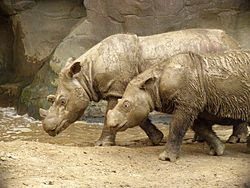Sumatran rhino is one of the most critically endangered animals in the world.
The smallest member of the rhinoceros family once roamed as far as Myanmar, India and China. Today, there are less than
200 individuals left in the world, and they are all scattered across little pockets of forest in Malaysia and Indonesia.
 |
| Image: en.wikipedia.org |
Many people would cite deforestation and poaching as the two primary forces that are killing the animal. But those two clouts are also killing other animals. So if every species is facing the same threat, why is rhino's number dropping while the number of other endangered species manages to recover?
The problem, I believe, lies in the lack of research.
A search on the webofknowledge for the world "sumatran rhino" yielded only
24 publications over the past 27 years--that's less than one paper per year. On the other hand, other endangered species, even the lesser known species like the Asiatic lion yielded 37 more research paper than the sumatran rhino over the same period.
 |
| Image: natgeotv.com |
Last week
treehugger.com reported the comeback of the Californian dwarf island fox, which were reduced to just 15 individuals in the year 2000. A quick search on the webofknowledge yielded
6-pages of information, with each page contained up to 10 journal papers. Giant panda was once considered an impossible species to breed in captivity thanks to their
short fertility window--only fertile for 24~36 hours--which occurs only once a year. But today there are more than
300 pandas living in zoos and breeding centers around the globe.
The reason behind all these comebacks? Intense research and investigation.
 |
| Image: www.canids.org |
Let's face it, one paper per year is hardly enough to fulfill the Key Performance Indicator (KPI) of a modern day researcher, let alone the entire field of sumatran rhino research. Researchers and conservationists should ramp up their research output to at least two papers each per year. But even at the rate of two papers per year, it is still difficult for sumatran rhino research to catch up with the rate of poaching.
In June 2012, a
calf was born in captivity in western Indonesia. It is only the fifth known birth in captivity for the species in 123 years. Vietnam's Javan rhino was declared
extinct last year (2012). We don't have much time left for its sumatran cousin.
 |
| Image: rhinoprotectiontrust.co.za |
Malcolm




No comments:
Post a Comment